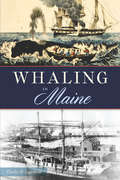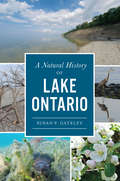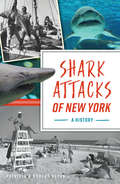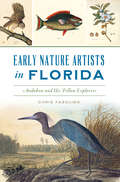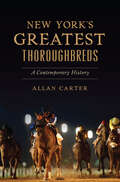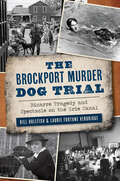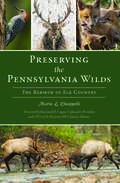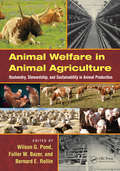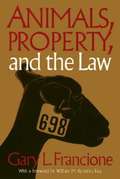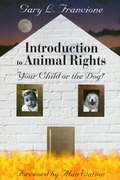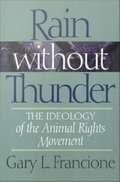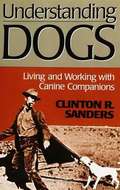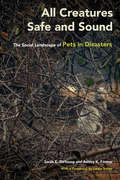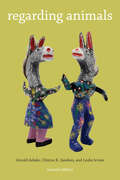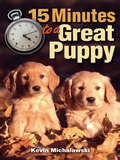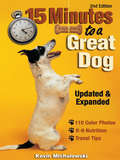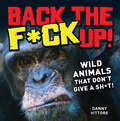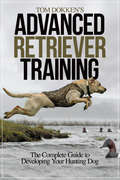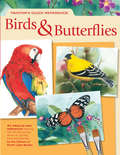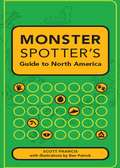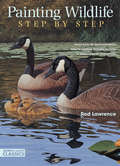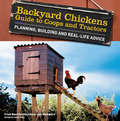- Table View
- List View
Whaling in Maine
by Charles H. LagerbomThe history of American whaling is most frequently associated with Nantucket, New Bedford and Mystic. However, the state of Maine also played an integral part in the development and success of this important industry. The sons of Maine became whaling captains, whaling crews, inventors, investors and businessmen. Towns along the coast created community-wide whaling and sealing ventures, outfitted their own ships and crewed them with their own people. The state also supplied the growing industry with Maine-built ships, whale boats, oars and other maritime supplies. For more than two hundred years, the state forged a strong and lasting connection with the American whaling industry. Author and historian Charles Lagerbom reveals why Maine should rightly take its place alongside its more well-known New England whaling neighbors.
A Natural History of Lake Ontario (Natural History)
by Susan P. GateleyFormed by glaciers more than twelve thousand years ago, Lake Ontario has captivated nature lovers for generations. Unique among the Great Lakes for having once been connected to the sea, fossils from ocean life have been found near the lake's shores. Damage done to Lake Ontario's ecosystem from centuries of human activity was center stage in the fight to pass the Clean Water Act and the restoration that followed. From incredibly diverse bird migrations in the spring and fall to the squalls and lake effect snow in winter, each season offers a rich ecological tapestry. Author Susan P. Gateley charts the natural history of Lake Ontario from its ice age origins to the climate and habitat challenges it faces today.
Shark Attacks of New York: A History (Disaster)
by Patricia Heyer Robert HeyerNew York's crowded beaches can come to halt with the shout of a single word: shark! The shores of Long Island and Staten Island and the waters surrounding Manhattan have had more than thirty shark attacks recorded since the days of New Amsterdam. Legend has it that Antony Van Corlear, Peter Stuyvesant's trusted deputy, was killed by a shark crossing Spuyten Duyvil Creek while blowing his famed trumpet. In the summer of 1916, after a series of bloody encounters along the Jersey Shore, sharks terrorized beachgoers of Sheepshead Bay, frightening the entire region. Two incidents on Fire Island in 2018 within mere hours and miles of each other involved a twelve-year-old and a thirteen-year-old, striking fear in the hearts of parents. Authors Patricia and Robert Heyer chart the history of New York's shark attacks.
Early Nature Artists in Florida: Audubon and His Fellow Explorers
by Chris FasolinoFlorida's amazing landscapes and fascinating wildlife were sources of inspiration for early naturalists seeking new horizons. Among them was John James Audubon. Elegant herons, acrobatic terns, endearing pelicans and colorful roseate spoonbills all feature among his beloved artwork. But Audubon was not the first nature artist inspired by Florida. Mark Catesby, an English country squire turned adventurer, helped introduce the wonders of Florida to a European audience in the 1700s. And William Bartram, a Pennsylvania Quaker, traveled south to explore the Florida wilderness, where he canoed across a lake full of alligators and lived to sketch the creatures. Author Chris Fasolino shares the stories of these artistic expeditions in a collection replete with gorgeous artwork that includes high-definition images of Audubon's rarely seen original paintings.
New York’s Greatest Thoroughbreds: A Contemporary History (Sports)
by Allan CarterChampion Race Horses of the Empire State From Saratoga to Belmont Park, New York hosts some of horse racing's most important races, but many of the most successful thoroughbreds of the past five decades also have called the state home. Say Florida Say seemed to only improve with age, winning thirty-three times throughout a seven-year career that made him a regional favorite in the 1990s. The first ever New York horse to win the Kentucky derby, Funny Cide, rose to national prominence in 2003, winning both the Derby and the Preakness in incredible fashion. The thoroughbred Audible shared owners with triple-crown winner Justify, and though embroiled in some controversy as a result, was also an elite race horse during a brief career. Author Allan Carter highlights the stories behind the greatest New York thoroughbreds of the past half-century.
The Brockport Murder Dog Trial: Bizarre Tragedy and Spectacle on the Erie Canal (True Crime)
by Bill Hullfish VerbridgeIn the summer of 1936, fourteen-year-old Maxwell Breeze was playing in the waters of the Erie Canal in Brockport when a dog jumped into the canal and climbed his back, and the boy drowned. The owner of the dog was served notice to appear at a hearing, at which time a trial was set to determine if the dog should be put down. The unusual case captivated the nation as newspapers from coast to coast covered the story, Paramount Pictures dispatched "The Eyes and Ears of the World" to film the events and a media circus descended on the quiet village. During the trial, more than thirty witnesses were called, including a national expert brought in to evaluate the canine defendant, which journalists referred to as "the most talked-of dog on earth." Authors Bill Hullfish and Laurie Fortune Verbridge reveal the bizarre incident, trial and spectacle that came to Brockport.
Preserving the Pennsylvania Wilds: The Rebirth of Elk Country (The History Press)
by Mario ChiappelliA Legacy of Conservation Every year thousands flock to the Pennsylvania Wilds to be among nature and its famous elk herd. In the past, dangerous levels of hunting and industrial development forever altered Pennsylvania's natural landscape and drove its native elk to near extinction. In response, concerned sportsmen and conservationists pushed the state legislature to create a game commission in the late 1800s to enforce game laws and protect the herd. The Pennsylvania Game Commission then sought to reintroduce the once mighty elk herd in the early twentieth century, shipping fifty elk via train from Jackson Hole and Yellowstone. Conservation movements continued to enhance the state's environmental landscape that faced new threats from logging and mining industries and by the 1980s, the Wilds was on a path to full restoration. Author Mario Chiappelli reveals the history of how the Pennsylvania Wilds and its elk herd remain as vibrant as ever today.
Animal Welfare in Animal Agriculture: Husbandry, Stewardship, and Sustainability in Animal Production
by Wilson G. Pond Fuller W. Bazer Bernard E. RollinWhat constitutes animal welfare? With animals being used for companionship, service, research, food, fiber, and by-products, animal welfare is a topic of great interest and importance to society. As the world's population continues to increase, a major challenge for society is the maintenance of a strong and viable food system, which is linked to t
Animals, Property, and the Law
by Gary L. Francione"Pain is pain, irrespective of the race, sex, or species of the victim," states William Kunstler in his foreword. This moral concern for the suffering of animals and their legal status is the basis for Gary L. Francione's profound book, which asks, Why has the law failed to protect animals from exploitation? Francione argues that the current legal standard of animal welfare does not and cannot establish fights for animals. As long as they are viewed as property, animals will be subject to suffering for the social and economic benefit of human beings. Exploring every facet of this heated issue, Francione discusses the history of the treatment of animals, anti-cruelty statutes, vivisection, the Federal Animal Welfare Act, and specific cases such as the controversial injury of anaesthetized baboons at the University of Pennsylvania. He thoroughly documents the paradoxical gap between our professed concern with humane treatment of animals and the overriding practice of abuse permitted by U. S. law. Author note: Gary L. Francione is Professor of Law and Nicholas de B. Katzenbach Scholar of Law at Rutgers University Law School, Newark. He is also Co-director of the Rutgers Animal Rights Law Center.
Introduction to Animal Rights: Your Child or the Dog?
by Francione Gary L.Two-thirds of Americans polled by the Associated Press agree with the following statement: "An animal's right to live free of suffering should be just as important as a person's right to live free of suffering. " More than 50 percent of Americans believe that it is wrong to kill animals to make fur coats or to hunt them for sport. But these same Americans eat hamburgers, take their children to circuses and rodeos, and use products developed with animal testing. How do we justify our inconsistency? In this easy-to-read introduction, animal rights advocate Gary Francione looks at our conventional moral thinking bout animals. Using examples, analogies, and thought-experiments, he reveals the dramatic inconsistency between what we say we believe about animals and how we actually treat them. Introduction to Animal Rights: Your Child or the Dog? provides a guidebook to examining our social and personal ethical beliefs. It takes us through concepts of property and equal consideration to arrive at the basic contention of animal rights: that everyone -- human and non-human -- has the right not to be treated as a means to an end. Along the way, it illuminates concepts and theories that all of us use but few of us understand -- the nature of "rights" and "interests," for example, and the theories of Locke, Descartes, and Bentham. Filled with fascinating information and cogent arguments, this is a book that you may love or hate, but that will not fail to inform, enlighten, and educate.
Rain without Thunder: The Ideology of the Animal Rights Movement
by Francione Gary L.Are "animal welfare" supporters indistinguishable from the animal exploiters they oppose? Do reformist measuresreaffirmthe underlying principles that make animal exploitation possible in the first place? In this provocative book, Gary L. Francione argues that the modern animal rights movement has become indistinguishable from a century-old concern with thewelfareof animals that in no way prevents them from being exploited. Francione maintains that advocating humane treatment of animals retains a sense of them as instrumental to human ends. When they are considered dispensable property, he says, they are left fundamentally without "rights. " Until the seventies, Francione claims, this was the paradigm within which the Animal Rights Movement operated, as demonstrated by laws such as the Federal Humane Slaughter Act of 1958. In this wide-ranging book, Francione takes the reader through the philosophical and intellectual debates surrounding animal welfare to make clear the difference between animal rights and animal welfare. Through case studies such as campaigns against animal shelters, animal laboratories, and the wearing of fur, Francione demonstrates the selectiveness and confusion inherent in reformist programs that target fur, for example, but leave wool and leather alone. The solution to this dilemma, Francione argues, is not in a liberal position that espouses the humane treatment of animals, but in a more radical acceptance of the fundamental inalienability of animal rights. Author note:Gary L. Francioneis Professor of Law and Nicholas de B. Katzenbach Scholar of Law at Rutgers University Law School, Newark. He is the co-director of the Rutgers Animal Rights Law Center and the author ofAnimals, Property, and the Law(Temple).
Understanding Dogs: Living and Working with Canine Companions
by Sanders Clinton R.Can people have authentic social relationships with speechless animals? What does your dog mean to you, your understanding of yourself, and your perceived and actual relationships with other s and the world? What do you mean to your dog? In Understanding Dogs, sociologist and faithful dog companion Clinton R. Sanders explores the day-to-day experiences of living and working with domestic dogs. Based on a decade of research in veterinary offices and hospitals, dog guide training schools, and obediences classes -- and colored with his personal experiences and observations at and outside home with his own canine companions -- Sanders's book examines how everyday dog owners come to know their animal companions as thinking, emotional, and responsive individuals. Linking animal companionship with social as well as personal identity, Understanding Dogs uses detailed ethnographic data in viewing human and animal efforts to understand, manipulate, care for, and interact with each other. From nineteenth-century disapproval of what was seen as irresponsibly indulgent pet ownership among the poor to Bill Clinton's caring and fun-loving image and populist connection to the "common person" as achieved through his labrador companion Buddy, Sanders looks at how dogs serve not only as social facilitators but also as adornments to social identity. He also reveals how, while we often strive to teach and shape our dogs' behavior, dogs often teach us to appreciate with more awareness a nourishing meal, physical warmth, a walk in the woods, and the simple joys of the immediate moment. Sanders devotes chapters to the specialized work of guide dog trainers; the problems and joys experienced by guide dog owners; the day-to-day work of veterinarians dealing with the healing, death, and euthanizing of their animal patients; and the everyday interactions, assumptions, and approaches of people who choose, for various reasons and in various ways, to spend their lives in the company of dogs. Understanding Dogs will interest those who live and work with animals as well as those studying the sociology of human-animal interactions.
All Creatures Safe and Sound: The Social Landscape of Pets in Disasters
by Sarah E. DeYoung Ashley K. FarmerSome of the most striking news stories from natural disasters are of animals tied to trees or cats swimming through murky flood waters. Although the issue of evacuating pets has gained more attention in recent disasters, there are still many failures throughout local and national systems of managing pets and accommodating animals in emergencies. All Creatures Safe and Sound is a comprehensive study of what goes wrong in our disaster response that shows how people can better manage pets in emergencies—from the household level to the large-scale, national level. Authors Sarah DeYoung and Ashley Farmer offer practical disaster preparedness tips while they address the social complexities that affect disaster management and animal rescue. They track the developments in the management of pets since Hurricane Katrina, including an analysis of the 2006 PETS Act, which dictates that animals should be included in hazard and disaster planning. Other chapters focus on policies in place for sheltering and evacuation, coalitions for animal welfare and the prevention of animal cruelty, organizational coordination, decision-making, preparedness, the role of social media in animal rescue and response, and how privilege and power shape disaster experiences and outcomes. Using data they collected from seven major recent American disasters, ranging from Hurricanes Harvey, Irma, and Florence to the Camp, Tubbs, and Carr Fires in California and the Hawaii Lava Flow, the authors provide insights about the successes and failures of animal care. All Creatures Safe and Sound also outlines what still needs to change to best prepare for the safety and welfare of pets, livestock, and other companion animals in times of crisis.
Regarding Animals (Animals Culture And Society)
by Arnold Arluke Clinton Sanders Leslie IrvineWinner of the Charles Horton Cooley Award, Society for the Study of Symbolic Interaction, 1997 The first edition of Regarding Animals provided insight into the history and practice of how human beings construct animals, and how we construct ourselves and others in relation to them. Considerable progress in how society regards animals has occurred since that time. However, shelters continue to euthanize companion animals, extinction rates climb, and wildlife “management” pits human interests against those of animals. This revised and updated edition of Regarding Animals includes four new chapters, examining how relationships with pets help homeless people to construct positive personal identities; how adolescents who engage in or witness animal abuse understand their acts; how veterinary technicians experience both satisfaction and contamination in their jobs; and how animals are represented in mass media—both traditional editorial media and social media platforms. The authors illustrate how modern society makes it possible for people to shower animals with affection and yet also to abuse or kill them. Although no culture or subculture provides solutions for resolving all moral contradictions, Regarding Animals illuminates how people find ways to live with inconsistent behavior.
15 Minutes to a Great Puppy
by Kevin MichalowskiDiscover the 15-Minute Miracle!Puppies bring great joy to our lives, but they also present us with special challenges. Everyone wants a well-behaved dog that is a joy to be around, but who has time for training a puppy? You do - and if you do it right, it will only take 15 minutes of your time each day.Kevin Michalowski's formula for a great puppy is a proven winner for time strapped pet owners. He teaches us that dog training is all about short, effective sessions. His plan is so simple and easy that anyone can follow it.This book is a must-have for anyone who is thinking about getting a puppy. It is packed with great, practical information to help you get ready for your new dog to help you with all the basic training lessons.You'll discover how to:Prepare yourself - mentally and physically - for getting a dogPick the right puppy for your lifestyle - includes a quick-reference breed guideHousebreak your dog that easy way, thanks to the crate and the scheduleTeach the four basic commands: Sit, Come, Heel and DownCure problems such as chewing, jumping and aggressionMonitor your dog's health and give it a happy lifeYour puppy will become your best friend - and with just 15 minutes of training per day, he can also become the well-behaved dog of your dreams.
15 Minutes to a Great Dog
by Kevin Michalowski Michalowski KevinYou Now Have Time to Train a Dog!All it takes is 15 minutes!This expanded second edition shows dog owners proven, effective tips for training any dog in just minutes a day. You don't need special skills or expensive equipment and you don't need hour upon hour of free time. Short simple training sessions work best.Teaching any dog basic obedience skills can be done just about anywhere and will work on dogs of all ages and breeds. Repetition and consistency are the keys to making dogs behave.This expanded edition not only provides proven tips anyone can use, it also includes an expanded chapter on canine nutrition and information on traveling with your pet.Take the drudgery out of training, keep the training fun for both you and the dog and watch the amazing results in as little as 15 minutes each day.
Back the F*ck Up!: Wild Animals That Don't Give a Sh*t!
by Danny VittoreHoly Sh*t! Run for your lives! The animal kingdom is a messed-up place. Good thing you don't have to live in it because there are animals that would make Chuck Norris look like a wuss. In this tell-all tale of Animals Gone Wild, humorist Danny Vittore introduces you to the F U attitude of creatures great and small, including the fearless honey badger, which has the balls to take on lions and king cobras just for laughs; Gary Busey batsh*t crazy squirrels; and cane toads, which love to hump things Jersey Shore style.
Tom Dokken's Advanced Retriever Training: The Complete Guide to Developing Your Hunting Dog
by Tom DokkenYou will enjoy Dokken's famous no-nonsense, common-sense training approach for taking retrievers to an advanced level. In addition, you will see those principles in action via professional photography from Lee Thomas Kjos. Best, you can implement these training principles at your own pace and as your schedule allows.You will also enjoy:Proven professional training techniques for molding great finished retrieversStep-by-step photographic instructionTrouble-shooting advice for any training dilemma
Painter's Quick Reference Birds & Butterflies: Birds And Butterflies
by Editors of North Light BooksThe perfect reference for painters! Brighten your paintings with colorful birds and butterflies. Inside you'll find more than 40 step-by-step demonstrations to help you accurately render beautiful butterflies and a wide variety of songbirds, water birds and exotic birds including goldfinches, hummingbirds, cardinals, mallards and peacocks. You'll also learn how to embellish your paintings with individual feathers, eggs and a nest. This special guide features painting instruction and advice from 11 professional artists working in acrylics, watercolors, oils and colored pencils. Each demonstration includes a detailed materials list to make it even easier for you follow along. This invaluable combination of in-depth painting demonstrations and inspiring ideas is guaranteed to bring you success in all your work.
Monster Spotter's Guide to North America
by Scott FrancisLike a bird-watching guideà only for monstersMonsters represent the dark side of humanity–the primal, animal impulses that reside in every single one of us. They have preyed upon our imaginations and our fears since the dawn of civilization.North America is home to a wide array of fearsome beasts, including hairy monsters, flying monsters, lake monsters, and other unexplained phenomena. Monster Spotter's Guide geographically catalogs more than one hundred legendary monsters reported to inhabit the continent.From the mythical Sasquatch of the Pacific Northwest to the vicious Mexican goatsucker known as El Chupacabra, you'll read about the legends and major sightings of the most widely feared creatures reported to exist–plus a few you might have never heard of.Within these pages you'll find detailed pen-and-ink drawings, helpful quick-reference boxes for immediate identification of key monster traits, a glossary of cryptozoology terms, useful appendices, case studies and more.Let this book be your guide, and explore the legends for yourself. Anyone can be a monster spotteràwhen you start looking, you never know what you might find.
Monster Spotter's Guide to North America
by Scott FrancisLike a bird-watching guideà only for monstersMonsters represent the dark side of humanity–the primal, animal impulses that reside in every single one of us. They have preyed upon our imaginations and our fears since the dawn of civilization.North America is home to a wide array of fearsome beasts, including hairy monsters, flying monsters, lake monsters, and other unexplained phenomena. Monster Spotter's Guide geographically catalogs more than one hundred legendary monsters reported to inhabit the continent.From the mythical Sasquatch of the Pacific Northwest to the vicious Mexican goatsucker known as El Chupacabra, you'll read about the legends and major sightings of the most widely feared creatures reported to exist–plus a few you might have never heard of.Within these pages you'll find detailed pen-and-ink drawings, helpful quick-reference boxes for immediate identification of key monster traits, a glossary of cryptozoology terms, useful appendices, case studies and more.Let this book be your guide, and explore the legends for yourself. Anyone can be a monster spotteràwhen you start looking, you never know what you might find.
Monster Spotter's Guide to North America
by Scott FrancisLike a bird-watching guide... only for monsters Monsters represent the dark side of humanity–the primal, animal impulses that reside in every single one of us. They have preyed upon our imaginations and our fears since the dawn of civilization. North America is home to a wide array of fearsome beasts, including hairy monsters, flying monsters, lake monsters, and other unexplained phenomena. Monster Spotter's Guide geographically catalogs more than one hundred legendary monsters reported to inhabit the continent. From the mythical Sasquatch of the Pacific Northwest to the vicious Mexican goatsucker known as El Chupacabra, you'll read about the legends and major sightings of the most widely feared creatures reported to exist–plus a few you might have never heard of. Within these pages you'll find detailed pen-and-ink drawings, helpful quick-reference boxes for immediate identification of key monster traits, a glossary of cryptozoology terms, useful appendices, case studies and more. Let this book be your guide, and explore the legends for yourself. Anyone can be a monster spotter...when you start looking, you never know what you might find.
Monster Spotters Guide to North America
by Scott FrancisLike a bird-watching guide? only for monsters Monsters represent the dark side of humanity#150;the primal, animal impulses that reside in every single one of us. They have preyed upon our imaginations and our fears since the dawn of civilization. North America is home to a wide array of fearsome beasts, including hairy monsters, flying monsters, lake monsters, and other unexplained phenomena. Monster Spotter's Guidegeographically catalogs more than one hundred legendary monsters reported to inhabit the continent. From the mythical Sasquatch of the Pacific Northwest to the vicious Mexican goatsucker known as El Chupacabra, you'll read about the legends and major sightings of the most widely feared creatures reported to exist#150;plus a few you might have never heard of. Within these pages you'll find detailed pen-and-ink drawings, helpful quick-reference boxes for immediate identification of key monster traits, a glossary of cryptozoology terms, useful appendices, case studies and more. Let this book be your guide, and explore the legends for yourself. Anyone can be a monster spotter'when you start looking, you never know what you might find.
Painting Wildlife Step by Step: Learn from 50 demonstrations how to capture realistic textures in watercolor, oi l and acrylic
by Rod LawrenceEasy-to-follow, step-by-step demonstrations in acrylic, watercolor and oil Inside, you'll learn how to create realistic wildlife paintings, step by step, mastering dozens of specific wildlife textures, including: Fur of a bobcat, American bison, snow leopard cub and wolf Feathers of a wood duck, white-throated sparrow and northern shoveler Scales of a trout and sunfish Ears of a cottontail rabbit, white-tailed deer and red fox Bills and Muzzles of a northern cardinal, mallard, great blue heron and mountain lion Tails and Feet of a red squirrel, ruffled grouse and blue jay Antlers and Horns of a deer, moose, bighorn sheep and pronghorn White and Black Subjects such as a polar bear, tundra swan and Canada goose Through, you'll benefit from Rod Lawrence's years of wildlife painting experience. He'll help you notice, for example, the way hair and feature textures change on different parts of an animal's body through the seasons - and even according to the age of the animal. Use this heightened awareness, along with the easy-to-follow, step-by-step demonstrations inside, to create more realistic, more sensitive wildlife paintings.
Backyard Chickens' Guide to Coops and Tractors: Planning, Building, and Real-Life Advice
by Members of Backyard Chickens.comKeeping chickens isn't just for farms! The backyard chicken revolution has coops popping up in neighborhoods all over. Home-raised chickens provide a great source of superior, organic eggs that are as close as your backyard. Chickens also make good pets and provide free fertilizer-and lots of fun. Backyard Chickens Guide offers plans and photos for 16 custom coops built by real chicken owners, (including three portable designs known as tractors). Read their stories and learn from their experiences, then head out to the backyard to start your own flock.
